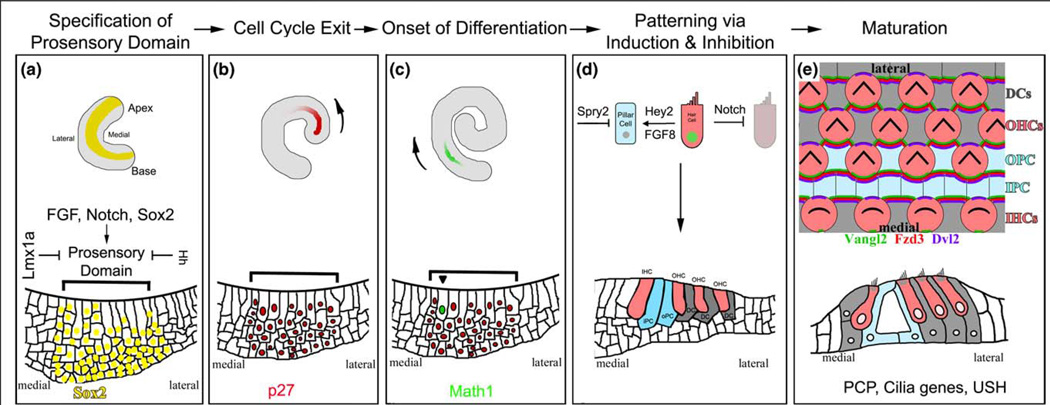Figure 2.
The development of the auditory sense organ. (A) The cochlear duct begins as an expansion of the ventral-most portion of the otocyst. Initial specifications of prosensory domain most likely begin as soon as the cochlear duct is recognizable. The prosensory domain is further restricted to a group of cells on the floor of the cochlea duct (shown with bracket) by the action of Sox2, Notch and Hedgehog (HH) signaling, and Lmx1a. Diagrams for the whole-mount cochlea (top) and the cross-section of the cochlea at this stage highlight the expression of Sox2 (yellow) in the prosensory domain. (B) The sensory precursor cells become postmitotic under the control of several cyclin-dependent kinase inhibitors, including p27. Cell cycle exit is initiated in the cells in the apical region and progresses toward the basal region, coinciding with the gradient of p27 onset in the cochlea. The arrow indicates the direction of onset of p27 and the gradient of cell cycle withdrawal along the longitudinal axis of the cochlear duct. (C) The first sign of differentiation within the postmitotic prosensory domain is the expression of the transcription factor Math1, which starts in the midbasal region and progresses toward both the apex and the base of the cochlea. There is also a second gradient along the medial-lateral axis of the cochlea from the inner to outer hair cells. The arrow indicates the longitudinal gradient of Math1 onset and hair cell differentiation. (D) Inductive and inhibitory signaling creates the correct cellular patterning of the organ of Corti. Much of this appears to be mediated by Notch signaling, which inhibits hair cell neighbors from adopting the same fate. Furthermore, the initial differentiation of the inner hair cells appears to direct the differentiation of other cells types, such as the Pillar cells (blue) through FGF8 and Hey2 in a Notch-independent manner. Sprouty 2 (SPY2) further restricts the differentiation of pillar cells. (E) During terminal differentiation and maturation, all cells in the organ of Corti coordinate their cellular morphologies under the regulation of the planar cell polarity (PCP) signaling pathway, which, in part, involves the asymmetric distribution of a core set of proteins (some examples are shown). The result of PCP signaling in the ear can be most clearly observed by the uniform orientation of the ‘V’-shaped hair bundles on the apical surfaces of hair cells. In mice, late embryonic and early postnatal hair cell and supporting cell types all undergo morphological and maturational changes that ultimately result in a highly sensitive sensory structure that is functional by two weeks after birth.

